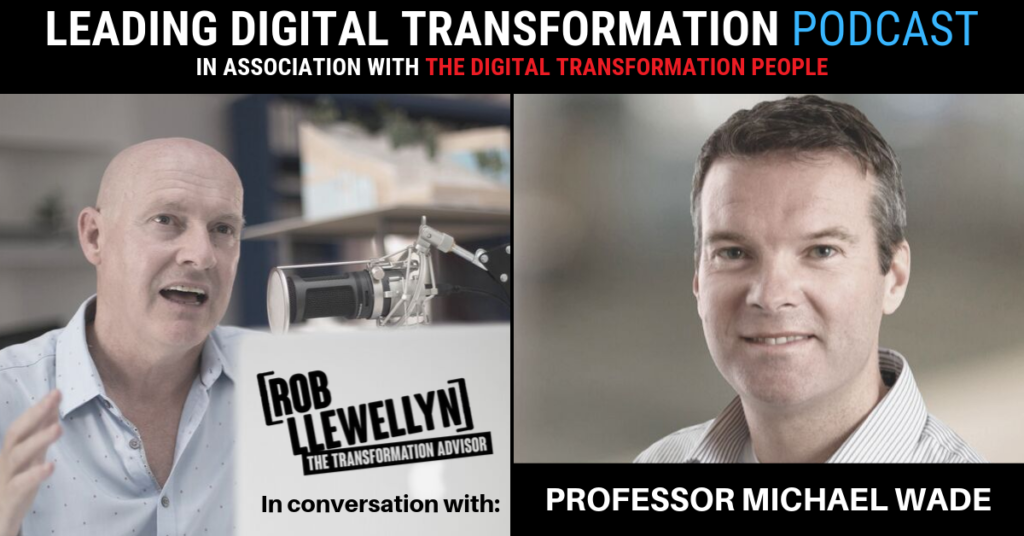‘Leading Digital Transformation’ is a weekly podcast series produced in collaboration between The Digital Transformation People and Rob Llewellyn digital transformation advisor and founder of CXO Transform.
During this series, Rob interviews experienced practitioners, authors and thought leaders whose stories and experiences provide valuable insights for digital transformation success.

In this episode, Rob speaks to Michael Wade, Professor of Innovation and Strategy at the IMD business school and the CISCO chair in Digital Transformation. As co-author of Digital Vortex, Mike researched and articulated the forces of digital disruption and now in his latest book Orchestrating Transformation he distils years of research and many case studies to show organisations how to avoid common mistakes and overcome the barriers to successful digital transformation.
“A common mistake we see is setting up the digital team to fail. So many companies see the threat of digital disruption, they go to conferences, they network with peers and everybody’s talking about digital and so they hire somebody to manage the digital transformation and unfortunately, that person is often set up to fail. They’re given a good title, they’re given a big responsibility but within the organization very little legitimacy to actually drive change and very often internally they are ignored.”
Listen here and read the full transcript below.
Rob Llewellyn [00:00:21] Hi and welcome to another episode. I’m joined today by Professor Michael Wade. Mike is a professor of innovation and strategy at IMD in Switzerland and he holds the CISCO chair in digital business transformation. He’s the director of the Global Centre for Digital Business Transformation which is an IMD and CISCO initiative and his areas of expertise relate to strategy innovation and digital transformation. Mike as published I believe at least nine books, more than 30 case studies and he appears frequently in mainstream media. His latest book is Orchestrating Transformation. He’s going to talk to us today about some of the concepts covered in the book. So let’s jump into the interview with Mike. Mike welcome.
Michael Wade [00:01:11] Thank you Rob.
Rob Llewellyn [00:01:12] Mike has been a good number of years since I attended one of your workshops at IMD at Lausanne in Switzerland. And I know since then you have come out with a few books. Can you tell us about those books before we get into transformation a little deeper?
Michael Wade [00:01:25] Sure I’d be happy to. In 2016 we released a book called Digital Vortex which is really about understanding the disruption that’s happening around us – particularly digital disruption. And in that book, we focus on a couple of things; we focus on the strategic level – how to frame a response to disruption if you’re a traditional company and we also focus on how you can become more agile as an organization in order to respond to an increasingly fast pace and unpredictable business environment, and then because time has moved on and people moved from needing to understand the dynamics of disruption to needing to figure out how to respond to them we produce a second book which we released earlier this year, 2019, called Orchestrating Transformation which is really an execution-focused book. So what do you need to do and quite practical terms to respond to the opportunities and threats that digital disruption brings.
Rob Llewellyn [00:02:26] So Mike, a lot of people listening know that transformation is easier said than done. What are some of the common transformation barriers that you’ve witnessed among the organizations that you work with?
Michael Wade [00:02:39] That’s true it’s not easy at the best of times. There’s some data around this and the best case seems to be about 70 per cent of these transformation efforts fail. But I’ve seen data that suggests up to 95 per cent of them fail so it’s certainly not easy. We’ve seen our fair share of failure but we don’t believe the foregone conclusion that these transformation efforts will fail. But there are certainly barriers as you point out. While to start with, there’s the technology barrier actually – figuring out how to use these digital tools and technologies. It’s not easy to do. Often the I.T. foundation within organizations is not scalable, robust enough to take on these new technologies so there’s kind of the technology barrier there for many companies. But in fact, that’s not the trickiest one. We see other barriers which are-, they may not show up immediately but they show up relatively quickly and then they can really throw a spanner in the works when it comes to transforming – for example, pilot organizations not other silos in the organizations that really inhibits the ability of digital tools to show benefits across organizations. So barriers, whether there are market barriers or product category barriers are functional barriers tend to inhibit the success of digital transformations. Another one is the culture of risk tolerance. A lot of organizations have a relatively low tolerance for risk and this can, again, quite significantly inhibit the ability of companies to respond to new opportunities and threats. And finally, there’s a barrier around the personnel, the people themselves. You know most companies have three types of people in them. When it comes to digital, there’s the ‘digital natives’ – the people who grew up with it, there’s ‘digital immigrants; – people like me I suppose who didn’t grow up with it but have sort of adapted, never gonna be natural for me but I can work with it. And then there’s a third category which is the ‘digital ignorants’ – those people who don’t really get it and have very little interest in learning about it. You may like to think that you should just get rid of those people but in fact, they’re bringing other things to the table like huge knowledge and experience in the business, great networks. So you need those people. So overcoming that barrier is one of the trickiest ones of all.
Rob Llewellyn [00:04:56] Mike we know that managers and leaders they’re all embarking on transformation with the very best of intentions to do the best that they can for their organizations. But you know they’re not all getting it right. What are some of the common transformation mistakes that we’re seeing?
Michael Wade [00:05:13] Yeah, that’s true. They are embarking on these journeys with the best of intentions but they do, as you point out, make a lot of mistakes so some common mistakes that we’ve encountered include-, well I guess one of the first ones that we see is focussing on digital for the sake of digital, you know because the tools and the technologies are super cool. A lot of companies you know they want to blockchain in there somewhere, they want deep learning or digital twin – they want these things so they focus on the technology rather than what it really brings to them as far as performance improvements. I think that the key switch that a lot of executives need to make is that digital is really a means to an end it’s not an end in and of itself. The objective is not to become more digital. The objective is to improve performance and digital is a means to get there. So that’s one common mistake we see. Another common mistake we see is setting up the digital team to fail. Unfortunately, we see this a lot so companies they see digital disruption, they go to conferences, they network with peers and everybody’s talking about digital and so they hire somebody to manage the digital transformation – a digital officer or chief transformation officer or someone else. And unfortunately, that person is often set up to fail. They’re given a good title, they’re given a big responsibility but within the organization very little legitimacy to actually drive change. So maybe they’re a group function and the lines of business are, you know they’re doing it anyway, Rob. You know they’re not waiting around for somebody from head office to tell them what to do so these transformation gurus tend to look good on panels and in conferences but internally they tend to be ignored. So I think you know in order to get that transformation team or digital team to be successful they need to have more than a nice title. They need to have real resources in order to go and leverage and scale the digital activities that really have benefit across the organization. So there are just two, there are many more, Rob. But I’ll just leave it at those two for now.
Rob Llewellyn [00:07:28] I want to go back to the first one you mentioned Mike. You know this focus on technology and you know obviously a lot of that comes from the technology element of an organization but you know as transformation-, as executives have become more aware of transformation and some of the pitfalls. Do you think executives are stopping this from happening, are they doing that? I’m talking about the likes of a CEO – are they stopping that excessive focus on technology or are they being led by, you know, that technology element of an organization into these technology-led initiatives for the sake of technology.
Michael Wade [00:08:04] I think there’s a natural progression that companies go through and it often starts with you know really focussing on the technology and then overplaying that hand and then coming back a little bit to prune the digital initiatives through the organizations and regard them as a portfolio like you might find a portfolio of other types of projects focussed clearly you know on business objectives. And I think the more mature organizations have already gone down that path and they’ve you know they focus more clearly their digital initiatives around certain key clear objectives out there. But you know, there’s sometimes the vendor eco-system is complicit in this problem. You know, technology vendors, consulting companies are very, very happy to help you become more digital and they will succeed all you need to do is give them money and they will make you more digital. But the question of whether that necessarily improves your performance or not is much less clear.
Rob Llewellyn [00:09:02] So moving away from this focus on technology Mike, agility has become quite a focus for a lot of organizations in recent years. What does it take to make an organization more agile?
Michael Wade [00:09:13] Right, and as you mention agile and agility have been a big focus and continue to be a big focus in organizations. They are actually problematic words I think Rob they mean different things to different people. So for some people you know Agile is basically just an I.T. way working methodology. For others it’s a more general way to frame a strategic flexibility in their organization. So a bit like the word ‘digital’. I think organizations at the very beginning should take time to clearly define what these words mean for them. You know what agile means for them, what transformation means for them, what digital means for them and at least as a common language around it that will help move forward because otherwise you know you have different people in the organization managing agile or digital and they’re all doing it to their best efforts but they’re all doing different things because there’s no common definition. But let me get back to your question about agile. We did look at this in a fair amount of detail to try and figure out from an organizational point of view what agile really is. And we came to the conclusion that agile is not a single thing at all. If you want to make the organization more agile it’s not a single thing, it’s three things and you need to do these three things well. The first thing that we identify as being a contributor to agility is something we call hyper-awareness [inaudible] capability. It’s really understanding what’s going on in your environment but not necessarily your immediate environment but the extended environment. So new, for example, new competitors, new technologies, new regulations that might impact the performance of your business that you’re aware of those. Also internally within the organization you’re hyper-aware about what your people are doing and saying, new ideas coming up within the organization. So it’s a much higher sensing capability but that’s not enough. I mean you can know a lot about what’s going on in your environment but you have to do something with that information. So the second step is something we call inform decision making. It’s building decisions on that information you’ve collected from being hyper-aware. And this sounds logical and sounds easy but in fact, most companies are not very good at this. You know they may collect a lot of information but it sits in a database and it’s not used to support decision making. So it’s really about evidence-based decision making it’s about using the information that you collect, sharing, collaborating empowering all that stuff but that’s not enough either. You have to do something once you’ve made a decision. So the third step of being agile from an organizational point of view is something we call fast execution – it’s putting those decisions into action at speed, which requires often, you know, new ways of making decisions and it often links to ”fast fail you know, going with an action even if you’re not a hundred per cent sure it’s balancing speed with perfection. Because when you execute something quickly you get insights and those insights feed back into the hyper-awareness. So it’s those three things Rob; hyper-awareness – knowing what’s going on informed decision making, translating those insights into decisions, and then fast execution translating those decisions into action. And that’s what we see as being the three components of agility from an organizational perspective.
Rob Llewellyn [00:12:30] Mike most of the people listening to this podcast right now they read and they hear about the typical disruption stories that have been taking place in recent years. How do disruptors disrupt traditional organizations?
Michael Wade [00:12:46] I don’t think it’s actually that tricky to understand how they do it. The way we see it after a lot of work that we’ve done to try to understand disruptors better is what we see is they’re doing they’re creating value for their customers in three fundamental ways. They’re creating cost value which is doing the same thing but cheaper. Creating experience value which is doing it better in some way that’s meaningful to customers. And the third category value is platform value. They’re building powerful platforms with network effects. That’s just an example of Uber Uber’s original concept was really a cost value benefit – it’s cheaper than a traditional taxi. And it is today in many places it’s cheaper than traditional taxi -that’s cost value. But most people don’t continue to use Uber because of that, they’re using it because of other benefits that are experience value benefits like it’s convenience, it’s safer, there’s ratings for the drivers, so you can have a good idea of the quality of experience in advance, the payment process is easy. And so forth but that’s not the only type of value that was created. They’ve also created platform value. So you don’t need to download a new app when you go to a different country, you know, one app works many places around the world. You don’t have to input your payment information anymore. This is because the power and scale of the platform and of course Uber’s cleverly now leveraging that platform for additional value for customers like in their Uber Eats operations where you can get food delivered, or logistics – packages and so forth. These are all-, they can do all these things because of the strength and power of their platform. So I think disruptors are doing these three things; they’re creating value in lower cost, cost value, better experiences and stronger platforms. And the most powerful disruptors are doing all three.
Rob Llewellyn [00:14:35] Mike, most of our listeners are involved in transformation in their organizations or are encouraging their organizations to get on that journey of transformation. And of course, some are doing it better than others. What should companies focus on to increase the chances of their transformation success?
Michael Wade [00:14:55] Well, I think there’s a couple of things that they could do. Clearly you know getting the technology right is important but I think there’s two key elements that they need to consider in addition to that. The first thing is really focussing on the cultural transformation. You know the organization itself has to come along for the ride with the journey so really focussing on; Do you have the right mindset to make the transformation? and if not how can you adjust, change your culture, move it, nudge it in the right direction in order to accept the changes and the transformations that are happening. So companies that tend to be successful in these digital transformations focus quite a lot on the cultural side. Another suggestion would be to invest in digital capability building, you know, getting those ‘digital ignorants’ and ‘digital immigrants’ over the line as far as the competencies, knowledge, skills that they need to understand. Maybe they’ll never be experts on digital but at least to understand the key trends and the key technologies so they’re qualified to make decisions and have discussions even if they’re not experts. And finally on the capability building side helping the digital natives to interact with the others in the organization, to understand their point of view and give them the business skills and knowledge that they maybe don’t have. So I think the focus on culture and the focus on capability building should go along with the more technology focussed side of a digital transformation in order to increase the chances of success.
Rob Llewellyn [00:16:23] Mike one term which you’ve mentioned a couple of times now the ‘digital ignorants’ and you mentioned at the start of the podcast that often these people are very experienced within an organization. Their experience of the business, they’ve been there a long time. So they have a lot to offer, however, are these people a danger to transformation unfolding in the way that it should in these organizations?
Michael Wade [00:16:48] They can be you know they can be blockers, certainly, but you know I think our experience is that most people even the digital ignorants are okay with change and transformation as long as they believe in the direction – as long as they understand and appreciate the need for change and where the company is going. The problem is if companies are not very clear on those things and it just becomes change or transformation for the sake of change and transformation without a lot of clear direction or purpose, and that’s what a lot of people react against – change is okay but they better know and they better agree on where the organization is going, if not they will certainly resist. So that’s incumbent upon top teams to make the journey very, very clear and the destination. And then give people the tools to go there. And I think if that’s the case those resisters will be less likely and less able to derail the journey.
Rob Llewellyn [00:17:50] So would I be right in saying really before transformation comes purpose and purpose defines what that transformation might look like, or what it might be intended to achieve? Is that right, Mike?
Michael Wade [00:18:00] Yeah but I think it’s even more than purpose – purpose is good for giving inspiration, but I think for this transformation to be successful you need to take that purpose down one level to something quite concrete. So what is the concrete objective of this transformation in terms that people understand? You know in terms that are relatively precise, realistic, succinct and measurable. And if people have that, you know, they know pretty much where they’re going and then you can give them the empowerment and the tools to get there in the way that they see the best way. And that also helps to remove the blockers of this traditional planning approach which is very rigid and not very agile.
Rob Llewellyn [00:18:39] Mike in your most recent book the title of the book is Orchestrating Transformation. Why is orchestration such a central focus of that book?
Michael Wade [00:18:49] Yes that’s a good question! You know another mistake that we see companies make is that they transform in silos and they do that for a very simple reason. That’s how they’re organized. So that’s kind of the most natural, easiest way to do it but in order to succeed in these transformations, in order to derive real benefits they have to work across silos. You know the digital tools that we’re talking about, the technologies, the business models, the benefit is the fact that they’re connected so the connectivity happens across these silos and the benefits are achieved when you can manage across silos. And so you have to break through those functions of silos and organizations and that’s the approach that we talk about and in that book is an orchestration approach where you’re orchestrating digital and you’re orchestrating transformation across the full extent of the organization. And we break down that orchestration challenge into distinct steps and distinct components which we describe in the book. And just like a conductor of an orchestra, you know, you have to make sure all the pieces, all the instruments are playing the right tune at the right time. It’s not just one instrument playing which is sometimes how it works in digital transformation it’s just really one group going for it, but it’s also not all the instruments playing their own tunes which you know sounds horrible! So it’s a matter of orchestrating all the different pieces in the service of this clear objective of transformation. And if organizations can do that effectively, I think there’s a much better chance of getting the benefits on the other end.
Rob Llewellyn [00:20:25] Now Mike, you and your colleagues who came out with the Digital Vortex book back in 2016 I believe and most recent book Orchestrating Transformation – anymore in the pipeline, Mike?
Michael Wade [00:20:35] Yeah. There are two more books that we’re working at the moment. One is a handbook actually-, sort of a very practical guide for people who are in the middle of these transformations. So, you know, tools, and examples and frameworks and decision trees and things that you would need when you’re in the fog of war of one of these transformation journeys to help you, you know, in that book we’re developing a list of key questions that people ask such IoT you know who should be in my team who has a very, very practical stuff like that. What type of project should we start with? Should you separate digital or integrate it? You know really practical questions that we’re creating a field book. And then the other project which is kind of an interesting one perhaps for your listeners is where we look at the transformation challenge from an individual point of view not – just from an organizational point of view. So as a leader, as a manager, as an executive what are the skills and behaviours and competencies that you need to develop in order to be successful in a world which is very dynamic, fast-changing and unpredictable. With everything we know about leadership from the last hundred years of research on what precisely what things are still valid but at the same time, what things are different? what things are new? and how do you develop those competencies – so that will also be coming out. So there are a few things still in the pipeline Rob. We’re not done yet.
Rob Llewellyn [00:21:59] Excellent. Looking forward to those. Mike we’re going to have to wrap it up there. Before we go of course people can pick up a copy of the Digital Vortex if they haven’t already done so and also your most recent book Orchestrating Transformation and we’ll put links to those in the show notes. I know you share a lot of information on transformation. Where else can people go to learn more about what you share on this topic of transformation?
Michael Wade [00:22:24] Well sure. You know IMD which is the institute they work with for executive education. We have a research centre there that I direct called the Global Centre for Digital Business Transformation and we have a website which is if you go to IMD and then you click on the website for our research centre we post pretty much everything that we produce. We post there for anybody to collect. And there’s also on that site there’s any kind of media that we do, we provide links there. So you know the latest examples and so forth so that’s the best, that’s the go-to location, the website the go-to location for the latest stuff that we’re producing. So I’d suggest going there.
Rob Llewellyn [00:23:05] Excellent. We’ll put links to those in the show notes. Mike thank you so much for your time today.
Michael Wade [00:23:09] My pleasure Rob. Best of luck to all your listeners who are in the middle of these transformation journeys. Yes, there’s a big legacy of failure out there but we also see successes. So best of luck.
Announcer [00:23:19] We hope you enjoyed this episode of “Leading Digital Transformation” with Rob Llewellyn and The Digital Transformation People. Visit www.thedigitaltransformationpeople.com to secure the knowledge, talent and services you need for digital transformation success. To continue your journey as a certified transformation professional, visit www.RobLlewellyn.com. Be sure to subscribe to the podcast and follow us on Twitter @TheDigitalTP and @RobertLlewellyn
Article by channel:
Everything you need to know about Digital Transformation
The best articles, news and events direct to your inbox
Read more articles tagged: Change & Transformation, Culture, Featured, Leadership






